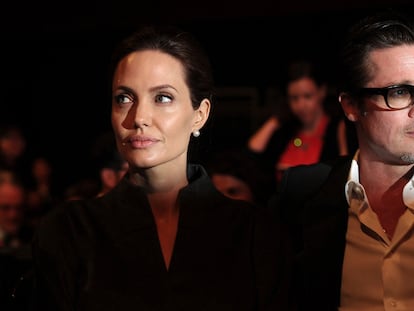Brad Pitt or how to turn a movie press tour into a personal PR campaign
With his children publicly disowning him, the actor has gone into damage control and resurrected his bromance with George Clooney in the new movie ‘Wolfs’ in a bid to present himself in a more favorable light

The latest cover of men’s magazine GQ is making waves. And with good reason. It stars two of the biggest stars in Hollywood: actors who can still boast that they are recognized on the streets of New York, Warsaw and Kuala Lumpur. “Brad Pitt and George Clooney are Hollywood’s BFFs,” reads the headline of the piece written by journalist Zach Baron. The actors are about to release the film Wolfs, which will premiere at the Venice Film Festival.
It is the first time the two have worked together since Burn After Reading, the Coen brothers film that was released in 2008. Previously, Pitt and Clooney had collaborated in box office smash hit Ocean’s Eleven and its subsequent sequels, and it was common to see them together smiling on the red carpet and at awards ceremonies, and to hear them talk about their friendship in promotional interviews.
Pitt and Clooney are known for their bromance: one of those male platonic friendships that wins over audiences. It’s as a great PR tool, a way to show that Hollywood is not as competitive and cut-throat as it is painted, and that actors, in the end, are ordinary people, even if they fly in private jets. Indeed, the GQ article focuses entirely on the Pitt-Clooney bromance. And that is the other reason why it is causing a stir on social media: the interview is seen as Pitts’ new attempt at damage control as he deals with the fallout of his bitter separation from Angelina Jolie, and his children’s decision to drop his surname.
In the interview, the actors talk about Cary Grant, Gregory Peck and Robert Redford, positioning themselves as the heirs of those great movie stars. They talk about the great studios of the past, such as Paramount, with admiration and nostalgia, despite presenting a film produced by Apple Studios. They remember their first successes and chat about the weight of fame. It’s all good vibes, camaraderie and shared experience. It’s all old Hollywood. And the whole conversation takes place, precisely, at the Château Miraval, Pitt’s vineyard in France, which is at the center of his dispute with Jolie, with whom he has six children, including three adopted kids.
Nothing in Hollywood happens by chance. Even less so when it comes to stars of Pitt’s level. It was precisely Pitt who hired crisis management expert Matthew Hiltzik immediately after the actress filed for divorce in 2016. Hiltzik’s clients also include Johnny Depp, who hired him to face his ex-wife, Amber Heard, in court. From the moment the crisis management expert entered his life, Brad Pitt’s interviews have followed the same pattern. First, addressing his past, clouded by his problems with alcoholism, which he claims to have overcome (in the GQ interview, he talks about Alcoholics Anonymous and his path to sobriety); then focusing on his career as a producer (he is behind films such as Moonlight and 12 Years a Slave) and as an actor. Two areas in which, he does indeed have an impeccable track record.
Hiltzik’s strategy has been faultless so far. Despite Jolie’s accusations, little or nothing has affected Hollywood’s most desired man. Popular media such as TMZ, Us Weekly, Daily Mail and People easily bought into his story of redemption. As journalist Anne Helen Petersen explained in her popular newsletter Culture Study: “TMZ called Jolie’s countersuit a ‘smear campaign,’ claiming she had ‘poisoned the kids against Brad.’ [People] magazine also underlined that, according to a ‘source close to Pitt,’ the actor had dinner with his younger kids whenever they were in Los Angeles.”
But as Petersen points out, Pitt’s children are now publicly disowning their father, and they have not been photographed in his company for years, so the actor’s version of events does not stand up to scrutiny. Amid this crisis, what better than to revive a long-lasting bromance between two established actors and hear their thoughts on cinema and acting? The image of Pitt, smiling next to his best friend in the French vineyard where he married Jolie, is more about promoting the actor than it is about promoting the movie.

The paradigm may have changed, but the PR strategy harks back to the Golden Age of Hollywood, when five studios controlled all the actors and reaped the benefits of their talent. Between the 1920s and 1960s, the studios could turn any actor into a star, but they had to pay a price. Being part of the Hollywood star system came with caveats: actors had to sign exclusive contracts with the studios that could last for years, even if the studio decided not to give them work again after a box office failure. They were also not allowed to reject the roles offered to them. Often, they even had to change their name for something more attractive. Women, often, had to undergo cosmetic surgery. The studios even controlled the actors’ private lives, inventing non-existent romances to promote a film or forcing homosexual actors to marry women, as was the case with Rock Hudson and Phyllis Gates. All for fame, of course.
Many of these contractual requirements were aimed at limiting so-called reprehensible behavior that did not abide by the morals of the time. For example, there were clauses about nighttime outings and promiscuity. The Hollywood game was simple, understandable, and signed in paper: behave as you should, and you will be a star.
There is some controversy over exactly when the star system ended. It’s largely believed to have come to a demise at the end of the 1960s, when the old guard that controlled Hollywood was replaced by newcomers, television began to compete with movie theaters, and audiences began to look for more naturalness, not only in acting, but in the stars they admired. Others argue that the star system never really ended, but rather evolved. The control that had once been held by five major studios was divided up, like a pie, among actors, agents and PR agencies, producers and publicists. And that everything has continued exactly as it was in the Golden Age.
The problem for stars and superstars is that this control has also been left — albeit to a lesser extent — in the hands of the media and the public. And now, it is more than ever controlled by social media. As Claire Dederer explained in her book Monsters: A Fan’s Dilemma: “Biography used to be something you sought out, yearned for, actively pursued. Now it falls on your head all day long.” In this constant flow of content, it is impossible to Google Brad Pitt and only read about the release of his film with George Clooney. Control over what the public knows and doesn’t know is no longer in the hands of five major studios.
That’s why it’s no longer enough to make a movie, endure an endless day with the press and go to a movie premiere with the best of smiles. To entertain a public that wants more than Q&A interviews, actors must now be fresh and fun, generate content, eat spicy fried chicken, always be in character and do little dances on TikTok. Just think of Margot Robbie dressing up as a Barbie doll for a whole year. Not even the biggest movie stars can free themselves from the effects of information overload and the endless news feed. So why not use it for personal benefit? That’s what Hollywood has always done. And it’s been very lucrative.
Sign up for our weekly newsletter to get more English-language news coverage from EL PAÍS USA Edition
Tu suscripción se está usando en otro dispositivo
¿Quieres añadir otro usuario a tu suscripción?
Si continúas leyendo en este dispositivo, no se podrá leer en el otro.
FlechaTu suscripción se está usando en otro dispositivo y solo puedes acceder a EL PAÍS desde un dispositivo a la vez.
Si quieres compartir tu cuenta, cambia tu suscripción a la modalidad Premium, así podrás añadir otro usuario. Cada uno accederá con su propia cuenta de email, lo que os permitirá personalizar vuestra experiencia en EL PAÍS.
¿Tienes una suscripción de empresa? Accede aquí para contratar más cuentas.
En el caso de no saber quién está usando tu cuenta, te recomendamos cambiar tu contraseña aquí.
Si decides continuar compartiendo tu cuenta, este mensaje se mostrará en tu dispositivo y en el de la otra persona que está usando tu cuenta de forma indefinida, afectando a tu experiencia de lectura. Puedes consultar aquí los términos y condiciones de la suscripción digital.
More information
Archived In
Últimas noticias
Chris Martin, Taylor Swift, Elijah Wood and other famous wedding ‘crashers’
‘How does it feel to be a failure?’: Elizabeth Berkley’s journey from ‘Showgirls’ ridicule to vindication
The story of the Málaga virus: The code that haunted Google’s cybersecurity center director for 30 years
The impact of Ecuador’s mega-prison: A polluted river, cleared forests and military checkpoints
Most viewed
- Christian Louboutin: ‘Young people don’t want to be like their parents. And if their parents wear sneakers, they’re going to look for something else’
- The low-cost creative revolution: How technology is making art accessible to everyone
- Liset Menéndez de la Prida, neuroscientist: ‘It’s not normal to constantly seek pleasure; it’s important to be bored, to be calm’
- All the effects of gentrification in one corner of Mexico’s Colonia Roma
- December Social Security and SSI payments: Dates, double checks and the 2026 COLA increase











































